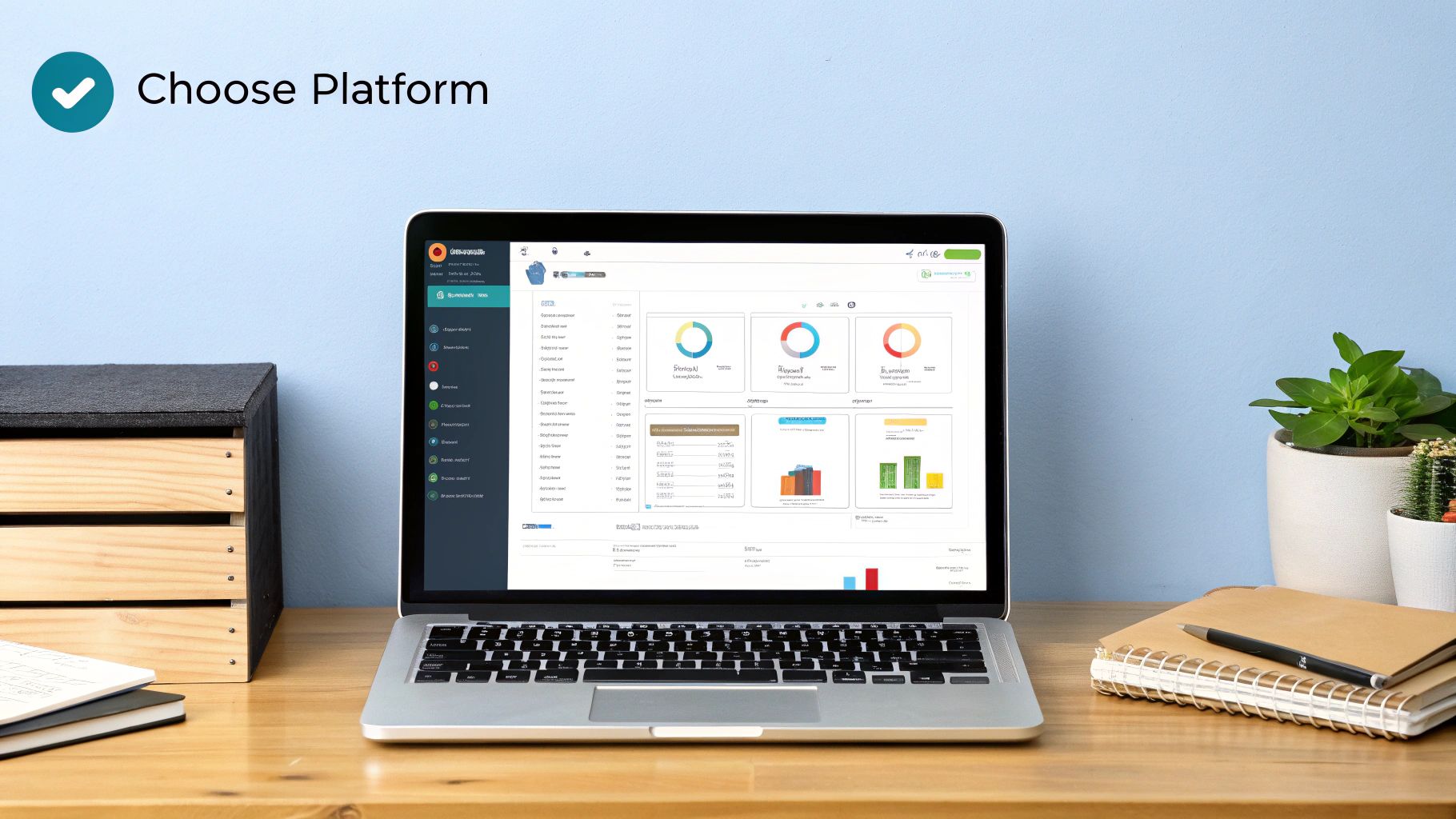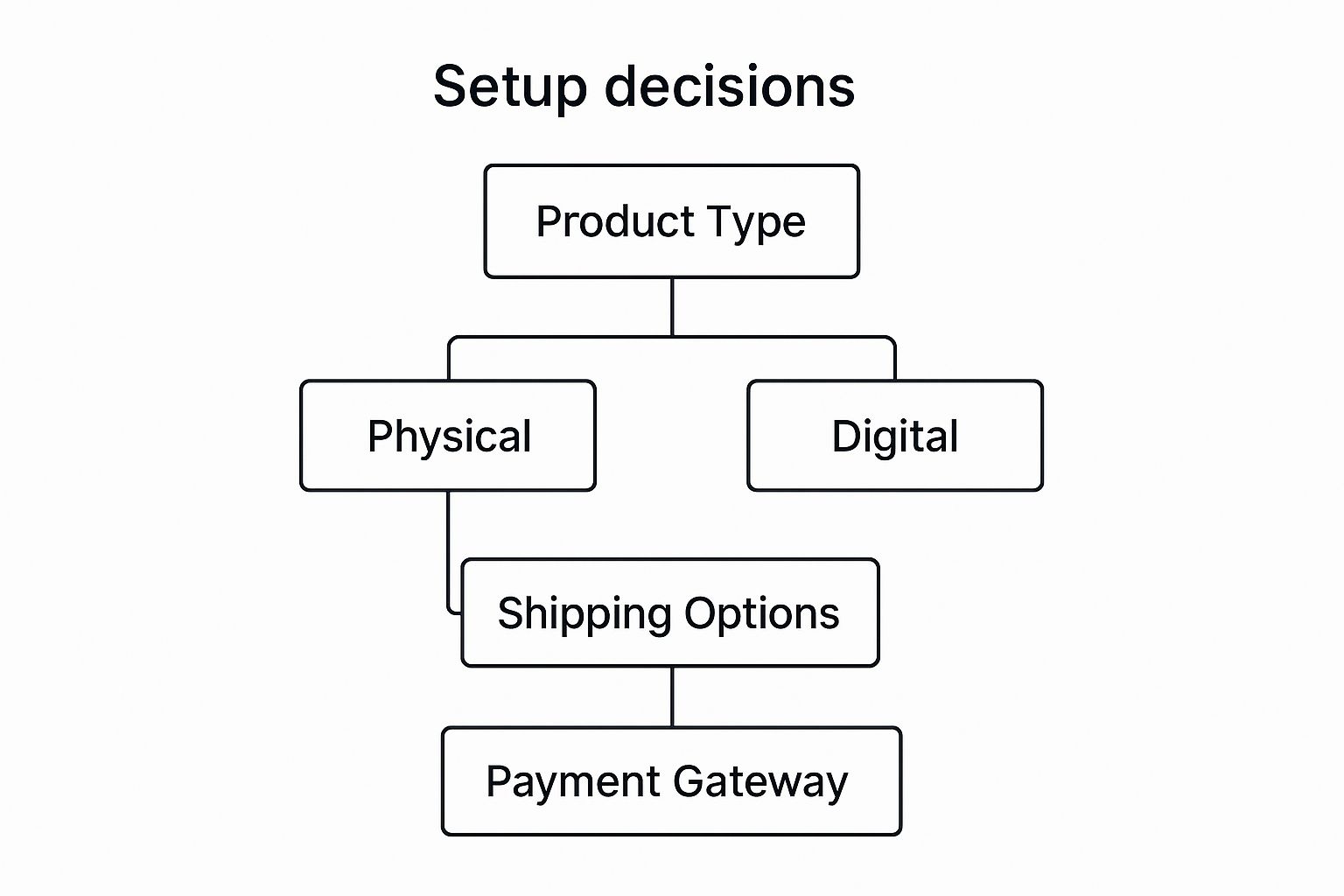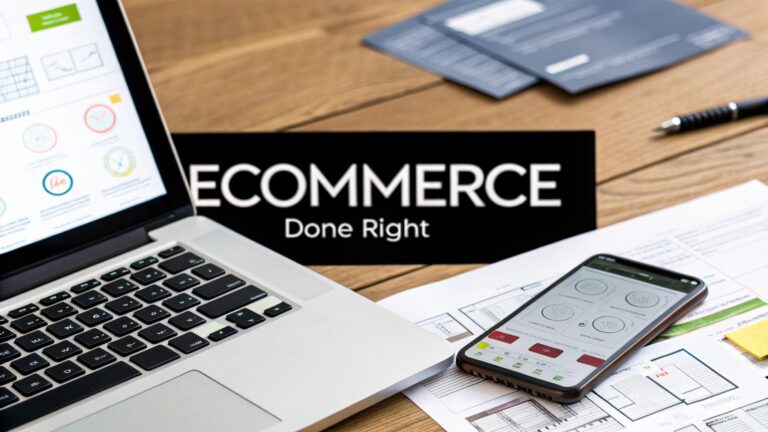Thinking about how to start an online store? The whole process really boils down to three core stages: validating your business idea, picking the right products and e-commerce platform, and then building a solid legal and financial foundation. This guide is your blueprint for taking a simple concept and turning it into your very first sale in the thriving UK market.
Your Blueprint for a Successful UK Online Store
Launching an online shop in the United Kingdom can feel like a massive undertaking, but honestly, it’s more achievable than most aspiring entrepreneurs think. The real secret isn't just having a brilliant product; it's about following a smart, strategic plan that covers every step of the journey. Think of this guide as your roadmap, designed to give you a realistic and actionable path forward.
We're going to move past the generic advice and get into the practical, nitty-gritty steps you need to build a business that lasts. This is more than a simple to-do list. It’s about building from the ground up, making sure every decision you make is informed and has a purpose.
The Current UK E-commerce Market
Frankly, there has never been a better time to jump into the UK's online marketplace. The United Kingdom is still Europe's biggest e-commerce market by a long shot, with British shoppers expected to spend over £183 billion online this year alone. That figure accounts for nearly a third (30.7%) of all projected UK retail sales.
This isn't just about the sheer size of the market; it reflects deeply ingrained consumer habits. With over 65 million people in the UK regularly shopping online, the average annual spend per person is around £3,600. For a deeper dive, you can explore the complete UK e-commerce sales benchmarks.
I see so many new business owners get intimidated by the market's size. My advice? Flip that thinking. See it as proof of the immense opportunity waiting for you. You’re launching to a mature, receptive audience that already trusts and understands online shopping.
Laying Your Strategic Foundation
Before you even think about logos or website colours, you need to nail down your strategy. A solid, well-thought-out concept is the bedrock of any successful online business. I always tell people to focus on these foundational pillars first:
- Validating Your Business Concept: How do you know if your idea will actually work? It all comes down to researching your target audience, figuring out their problems, and confirming they’re willing to pay for what you’re offering.
- Choosing and Sourcing Products: The items you sell are the heart and soul of your store. We'll get into how to pick profitable products and look at different ways to source them, whether you're making them yourself, buying wholesale, or dropshipping.
- Picking the Right Platform: Your e-commerce platform is your digital shopfront. Choosing the right one is absolutely critical for running your business smoothly and giving your customers a great experience.
Speaking of platforms, making the right choice early on can save you a world of headaches later. Each one has its own strengths, so it's worth taking a moment to compare the main players in the UK market.
UK E-commerce Platform At a Glance
Here’s a quick comparison of the most popular e-commerce platforms for new UK businesses, focusing on the key factors that will influence your decision.
| Platform | Best For | Typical Monthly Cost (GBP) | Ease of Use |
|---|---|---|---|
| Shopify | Beginners and businesses aiming to scale quickly. | £25 – £259 | Very user-friendly, drag-and-drop interface. |
| WooCommerce | Those who want full customisation on a WordPress site. | Free (but requires hosting, ~£10-£50+) | Steeper learning curve; requires some technical skill. |
| BigCommerce | Established businesses with large product catalogues. | £29 – £220 | Powerful but can be complex for newcomers. |
| Wix eCommerce | Small businesses and creatives needing a simple, all-in-one solution. | £17 – £27 | Extremely easy, ideal for visual-heavy sites. |
Ultimately, the "best" platform depends entirely on your specific needs, budget, and technical confidence. Shopify is often the go-to for its simplicity and scalability, while WooCommerce offers unparalleled control if you're comfortable with the tech side.
By getting these core areas sorted first, you're not just throwing a website together. You're deliberately creating a brand and a business that has what it takes to succeed in the competitive, but incredibly rewarding, world of UK e-commerce.
Finding Your Niche and Sourcing Products

Before you even think about website builders or marketing campaigns, your online store's success boils down to two critical questions: what are you going to sell, and who are you selling it to? Getting this right isn't about chasing a fleeting trend or just going with your gut. It’s about doing some practical groundwork to find a profitable corner of the market you can truly make your own.
This is where you sharpen a broad idea into a focused business concept. The goal is to find a niche market—a specific slice of a much larger market that has its own distinct needs. Instead of just selling "footwear," for example, you might zero in on "sustainable running shoes for urban commuters." This kind of focus helps you avoid going head-to-head with retail giants and allows you to connect with a dedicated audience that often feels overlooked.
How to Uncover a Profitable Niche
Finding the perfect niche feels a bit like being a detective. You're hunting for a group of people united by a shared passion, a common problem, or a specific identity, and then figuring out what products they're desperate for.
A brilliant place to start is with your own interests. Are you a weekend cyclist, a home barista, or a dedicated vegan baker? Tapping into your own expertise gives you an instant head start because you already understand the customer's world—their pain points, their desires, and what gets them excited.
Once you have a few ideas, you need to validate them. Dive into the online communities where your potential customers hang out. Places like subreddits, Facebook groups, and specialised forums are absolute goldmines. Look for patterns in their conversations: what are the common complaints? What products do they wish existed? This is raw, unfiltered insight you simply can't buy.
For instance, spending time in a home décor forum might reveal a common frustration: people with pets struggle to find stylish furniture that can withstand a bit of rough and tumble without costing a fortune. That single observation could be the spark for a niche store focused on durable, beautiful homewares designed for pet owners.
Even in a mature market like the UK, there's plenty of room to grow. Projections show online retail sales are expected to see a 4.5% year-on-year increase, signalling a healthy rebound. This growth is particularly strong in areas like homewares, furniture, and DIY, as people start spending on their homes again. You can dig deeper into these UK online retail sales forecasts to spot emerging opportunities.
Evaluating Your Niche Idea
Having a potential niche is one thing; knowing if it’s a viable business is another. Not every passion project can pay the bills. A truly profitable niche usually ticks these boxes:
- Real Demand: Are people actually searching for these kinds of products? Use a free tool like Google Trends to check search interest over time. A sudden spike might be a fad, but steady or growing interest is a great sign.
- A Passionate Audience: The best niches are built around genuine enthusiasm. This passion is what fuels word-of-mouth marketing and helps you build a loyal community, not just a customer list.
- A Clear Path to Profit: Be realistic. Can you source or create your products at a cost that leaves room for a healthy profit margin? Don't forget to factor in all the other costs, from marketing to shipping.
- Room to Do Better: Take a hard look at your potential competitors. Is their website a nightmare to use? Are their product photos blurry and uninspiring? Every weakness you spot is an opportunity for you to shine.
Choosing a niche you're genuinely passionate about is more than just good advice; it's a strategic advantage. When you love what you sell, your marketing becomes more authentic, your customer service is more empathetic, and you'll have the motivation to push through the inevitable challenges of starting a business.
Exploring Product Sourcing Models
Once you've settled on your niche, you need to decide how you'll actually get your hands on the products. There are several well-trodden paths, and your choice will have a huge impact on your startup costs, daily operations, and potential profit.
Popular Sourcing Methods for UK Stores
| Sourcing Model | Best For | Initial Investment | Level of Control |
|---|---|---|---|
| Dropshipping | Testing new ideas with minimal risk and offering a wide product range. | Very Low | Low (supplier handles stock & shipping) |
| Print-on-Demand | Creatives, artists, and brands selling custom-designed merchandise. | Very Low | Medium (you control designs, not production) |
| Wholesale | Businesses wanting more control over branding and faster shipping. | Medium to High | High (you manage your own inventory) |
| Handmade/DIY | Artisans and crafters offering unique, high-quality, bespoke items. | Low to Medium | Complete (you control every aspect) |
Let's say you decide to launch a store selling quirky tech gadgets. With dropshipping, you could partner with a supplier who ships orders directly to your customers. You never have to touch the inventory, which keeps your initial costs incredibly low. The downside? Your profit margins are typically thinner, and you have little control over the quality or speed of shipping.
On the other hand, if you're launching a boutique selling your own handmade jewellery, the DIY model gives you total creative freedom and much higher margins. The trade-off here is that production is your responsibility—it's time-consuming and can be difficult to scale up quickly. Thinking carefully about which model fits your vision is a fundamental part of building a successful online store.
Choosing Your Platform and Building Your Store

With your niche defined and product sourcing sorted, it's time to build your digital headquarters. The e-commerce platform you choose is the engine that will power your entire business, from the customer-facing shop front to the back-end where you’re managing orders and stock. Honestly, this is one of the most fundamental decisions you’ll make.
I like to think of it less like picking software and more like choosing a physical retail space. Some platforms are like renting a unit in a busy, all-inclusive shopping centre – they’re simple to set up and come with built-in tools. Others are like building your own boutique from scratch, giving you total creative freedom but demanding a lot more hands-on work.
Comparing the Top UK E-commerce Platforms
For most new businesses here in the UK, the choice usually comes down to a few major players. Each one has its own personality, and from my experience, they suit different types of entrepreneurs.
-
Shopify: This is the market leader for a reason. It's incredibly user-friendly, which makes it perfect for beginners who just want to get up and running without any fuss. Its real power, though, is how it grows with you. The huge app store means you can add almost any feature you can think of down the line.
-
WooCommerce: If you’re already comfortable with WordPress or you’re the type who wants ultimate control over every little detail, WooCommerce is a beast. It's an open-source plugin, so it's technically free, but you'll have to sort out your own web hosting. It offers unparalleled customisation, but be prepared for a steeper learning curve.
-
BigCommerce: This is a very strong contender, especially for businesses with a large and complex product catalogue. It has more robust features built-in from the start, so you might find you don't need to rely on as many paid apps as you would with Shopify.
Your platform choice affects everything from your monthly costs to your daily workflow. Don't just follow the crowd. Use the free trials to really get a feel for the dashboard and see which one clicks with your technical skills and business ambitions.
Setting Up Your UK-Specific Operations
Once you've picked your platform, the next job is to configure it specifically for the UK market. This is a crucial bit of admin that ensures a smooth ride for both you and your customers. Getting these details right from day one saves so many headaches later on.
First up, you need to integrate UK-friendly payment gateways. Most platforms support giants like Stripe and PayPal, but double-check that they’re set up correctly for GBP transactions. Offering familiar, trusted payment options is a simple trick to boost your conversion rates. Research consistently shows a clunky or untrustworthy checkout is a top reason for abandoned baskets.
Next, get your shipping carrier integration sorted. Your platform needs to connect smoothly with local carriers like Royal Mail, DPD, or Evri. This lets you offer accurate, real-time shipping quotes at checkout and print labels directly from your dashboard—a massive time-saver for your fulfilment process.
Finally, you have to think about VAT (Value Added Tax). Make sure your e-commerce platform has settings that allow you to apply VAT correctly according to UK rules. Even if you're not VAT-registered yet, it’s smart to pick a platform that handles it easily for when your business grows past the £90,000 threshold.
Designing a Storefront That Converts
With the technical nuts and bolts tightened, it’s time for the fun part: designing your online store. Your website’s design is so much more than just looking pretty; it’s your number one salesperson. It needs to look professional, feel trustworthy, and be dead simple to navigate.
Start with compelling product descriptions. This is your chance to shine as the expert. Don't just list features—sell the benefits. How will this product make your customer's life better, easier, or more fun? Write in a natural, conversational tone that speaks directly to your ideal buyer.
Pair those brilliant descriptions with high-quality product photos. Your customers can’t touch or feel the items, so your images have to do all the heavy lifting. Show products from multiple angles, show them in use, and include close-ups to highlight the quality and texture. You don’t need a fancy studio; a modern smartphone and good natural light can work wonders.
Then, organise your site with intuitive navigation. Your main menu should be clean and simple, guiding people effortlessly to your main product categories. A cluttered, confusing menu is a fast ticket to a frustrated visitor and a lost sale. For a deeper dive into this, check out our guide on essential e-commerce website design tips. A store that’s easy to browse is just as important as the products you sell.
Navigating UK Legal and Financial Setup
Alright, let's talk about the less glamorous, but absolutely critical, side of starting an online store: getting your legal and financial house in order. I know it’s tempting to jump straight into designing your website and curating products, but trust me, getting this stuff right from day one will save you from massive headaches later on.
A solid foundation here means you can grow your business with confidence, knowing you’re operating above board and your personal assets are protected.
Choosing Your Business Structure
One of the first big decisions you'll face is how to structure your business legally. In the UK, most e-commerce startups begin with one of two options: sole trader or a limited company.
-
Sole Trader: This is the simplest path. You are the business. There’s no legal separation between your personal and business finances, which makes setup a breeze—you just need to register for Self Assessment with HMRC. The catch? You're personally on the hook for any business debts.
-
Limited Company: Setting up a limited company (LTD) creates a distinct legal entity. This is a game-changer because it shields your personal assets, like your home, if the business gets into financial trouble. It also tends to look more professional to suppliers and partners. The trade-off is more admin, like filing annual accounts with Companies House.
Honestly, your choice boils down to your appetite for risk and your long-term vision. Many founders start as a sole trader for simplicity and then incorporate into a limited company once they see consistent revenue coming in.
Understanding Your VAT Obligations
Value Added Tax (VAT) is something you can't afford to ignore. For a new online shop, the magic number you need to remember is the VAT registration threshold.
Right now in the UK, you are legally required to register for VAT with HMRC as soon as your turnover from VAT-taxable goods hits £90,000 within any 12-month period. It’s also possible to register voluntarily before you hit this mark. This can be a smart move if you're buying a lot from other VAT-registered businesses, as you can then reclaim the VAT you’ve paid.
I’ve seen businesses get caught out by accidentally crossing the threshold, leading to hefty penalties for late registration. My advice? Set a monthly reminder in your calendar to check your rolling 12-month turnover. It’s a simple habit that will keep you out of trouble.
Managing Your Finances and Cash Flow
This is non-negotiable: keep your business and personal finances separate. The very first thing you should do after deciding on your business structure is to open a dedicated business bank account. It makes tracking your income and outgoings for tax purposes a million times easier and gives you a crystal-clear view of your business's financial health.
This visual helps map out the early operational choices you’ll be making, from the type of product you sell to how you'll get paid.

As you can see, fundamental choices, like whether you’re selling physical or digital goods, have a direct knock-on effect on your operational needs for things like shipping and payment systems.
Speaking of payments, a critical financial task is getting to grips with payment processing fees. Doing a proper payment processing fees comparison can uncover significant savings over the long haul. Those seemingly small percentages really do add up and can make a real difference to your profit margin.
Complying with Data Protection Laws
Finally, you absolutely must comply with UK data protection laws, chiefly the UK GDPR (General Data Protection Regulation). This set of rules dictates how you collect, handle, and use customer data.
From the moment you launch, your store needs a few key things in place:
- A Clear Privacy Policy: This document needs to spell out exactly what personal data you collect (names, addresses, emails), why you need it, and what you do with it.
- A Compliant Cookie Notice: You have to tell visitors about the cookies your site uses and get their permission before activating any that aren't strictly necessary for the site to function.
Getting this right isn't just about dodging fines; it’s about building trust. Customers are far more willing to part with their money when they feel a store is being transparent and respects their privacy.
Marketing Your Store and Driving Your First Sales

Getting your online store live is a massive achievement, but it's really just crossing the starting line. Now comes the exciting part: getting people to find your site and, more importantly, make their first purchase. Marketing isn’t some final step you bolt on at the end; it's the engine that will power your business from day one.
A common myth is that you need a huge marketing budget to make any real noise. That’s simply not true. What you really need is a smart, targeted approach that meets your ideal customers where they already are. Even with limited funds, you can build serious momentum.
The opportunity here is undeniable. Even when the wider economy feels a bit shaky, e-commerce has proven its resilience. In fact, the Office for National Statistics recently reported that the proportion of all retail sales made online climbed to 27.2%. It’s clear that the digital shelf is where the growth is happening.
Laying Your SEO Foundations
Search Engine Optimisation (SEO) is your long-game. It’s all about earning free, high-quality traffic from search engines like Google. Think about it: when someone types "handmade leather wallets" or "vegan dog treats" into that search bar, you want your store to be one of the first things they see.
This isn’t about finding a magic bullet for overnight success. It's about building a solid, trustworthy presence.
Start with the essentials:
- Keyword Research: Get inside your customer's head. What words are they actually using? Go beyond just your product name. For instance, if you sell face cream, don't just target that. Target the problem: "moisturiser for sensitive skin in winter."
- On-Page SEO: Weave these keywords naturally into your product titles, descriptions, and category pages. Make sure your page URLs are clean and tell a story, like
yourstore.co.uk/sustainable-bamboo-toothbrushes. - High-Quality Content: Write product descriptions that genuinely help people. Answer their questions, explain the benefits, and paint a picture of how your product will improve their life.
SEO is a marathon, not a sprint. You might not see big results for a few months, but the traffic it eventually brings is gold—it’s people actively looking for exactly what you sell.
Pro Tip: Don’t sleep on image SEO! Name your product photos descriptively (e.g.,
blue-cashmere-scarf.jpginstead ofIMG_1234.jpg) and always add "alt text" to describe the image for search engines and screen readers. This can be a surprising source of traffic from image searches.
Connecting with Your Audience on Social Media
While SEO works its magic in the background, social media is where you can actively build a community and show off your brand’s personality. This is your chance to connect with people on a human level.
The key is to pick the right platform for your brand. A new fashion boutique, for example, would be a natural fit for highly visual platforms like Instagram and TikTok. You could team up with local micro-influencers for authentic shout-outs or create short "how to style" videos. It's about building an aspirational lifestyle around your products.
On the other hand, a niche hobby store selling specialised model railway parts might find its tribe on Reddit or in dedicated online forums. Here, the owner can become a trusted expert, sharing their passion and answering technical questions. This builds incredible authority and a loyal following that will eventually buy from you.
As you scale, you'll find that investigating small business marketing automation can be a game-changer. These tools can handle scheduling and campaign management, freeing you up to focus on creating content that truly connects.
To help you decide where to start, here's a quick look at some popular channels for new businesses.
Beginner Marketing Channel Comparison
| Marketing Channel | Typical Cost | Effort Level | Time to Results |
|---|---|---|---|
| SEO | Low (mostly time) | High | Slow (3-6+ months) |
| Social Media (Organic) | Low | Medium-High | Medium (weeks-months) |
| Email Marketing | Low | Low-Medium | Fast (days-weeks) |
| Paid Ads (Social/Search) | High | Medium | Very Fast (days) |
| Influencer Marketing | Varies (Low to High) | Medium | Fast (weeks) |
This table gives you a rough idea, but remember that your mileage may vary. The best strategy is often a mix of channels—some for quick wins and others for long-term, sustainable growth.
Tapping into the Power of Email Marketing
Email marketing consistently delivers one of the best returns on investment out there. Why? Because you're talking to a warm audience—people who have already raised their hand and said they're interested. This is your direct line for building relationships and driving repeat sales.
Start collecting email addresses from your very first day. A simple pop-up on your site offering a small incentive, like 10% off their first order, is a classic and effective tactic.
Once you start building a list, you can put some simple but powerful automated emails to work:
- The Welcome Series: A sequence of 3-4 emails that automatically go out to new subscribers. Use them to share your brand story, highlight your bestsellers, and make them feel like part of the family.
- The Abandoned Cart Nudge: Life gets in the way, and people forget. A friendly email reminding them about the items they left in their basket can recover a surprising number of sales.
- The Post-Purchase Follow-up: After an order, send a thank-you note, share tracking information, and a week or two later, ask for a review. This closes the loop beautifully and encourages them to come back.
Marketing is an ongoing cycle of trying things, seeing what works, and doing more of that. By combining these channels, you create a powerful system to drive those crucial first sales and set your store up for the long haul. And always keep an eye on what's next by staying up to date on the top e-commerce trends shaping the future of online retail.
Common Questions About Starting an Online Store
Thinking about launching an online store naturally brings up a lot of questions. Getting straight answers is the first step to feeling confident and ready for what’s ahead. I’ve put together some of the most common queries I hear from new UK entrepreneurs to give you that clarity.
How Much Does It Really Cost to Start an Online Store in the UK?
This is the big one, isn't it? The honest answer is that it really depends on your ambition and model. It's entirely possible to get a simple, working shop live for under £100. That would cover your first month on a platform like Shopify, your domain name, and perhaps an essential app or two.
But for a more robust start, a realistic budget often sits between £500 and £2,000. This gives you room to breathe and covers the essentials properly.
- Platform Fees: A solid plan, like a basic Shopify subscription, will start around £25 per month.
- Domain Name: A
.co.ukdomain is your digital address and typically costs about £10-£15 a year. - Initial Stock: This is the biggest wildcard. If you’re dropshipping, your upfront cost is minimal. If you're buying products wholesale, this will be your main initial expense.
- Marketing Budget: You need to set aside something, even if it's small, for social media ads or content to get those first few visitors through the door.
A word of advice: don't confuse a low startup cost with an easy path. Your most valuable investment will always be your time. The hours you pour into learning the ropes, marketing your products, and looking after your customers will define your success far more than your initial budget.
How Long Does It Take to Get the First Sale?
Technically, you could build a great-looking store over a weekend. Platforms like Shopify have made the setup process incredibly user-friendly, so going from a spark of an idea to a fully functional website is faster than ever.
But launching your store is just the beginning. That first sale? It could happen in hours, or it might take a few months. The timeline hinges almost entirely on the work you do before and after you hit 'publish'. If you've spent time building an email list or a social media following beforehand, you could see sales on day one.
If you’re starting completely cold, it will take time for your marketing efforts to build momentum and for customers to find you. This is where patience and persistence pay off. Making your store visible is a long-term game, and learning how to rank higher on Google is a crucial strategy for attracting a steady stream of valuable traffic.
Do I Need to Register as a Business to Sell Online?
Yes, without a doubt. As soon as you begin trading with the intention of making a profit, you need to register your business with HMRC. You can't simply sell products online as a hobby and ignore the income.
For most newcomers, the most straightforward path is registering as a sole trader. The process is simple, and it means that legally, you and your business are one and the same. As your business grows, or if you decide you want to separate your personal and business finances, you can incorporate as a limited company. It's vital to handle this correctly from the start to stay compliant and avoid any headaches with the tax office down the line.
Starting and growing an online store is a challenge, but it's an incredibly rewarding one. At Ibertech Solutions Limited, we specialise in building bespoke e-commerce websites and crafting digital marketing strategies that help businesses across Norfolk and Suffolk flourish. If you're ready to transform your idea into a professional online store, visit us today to see how we can help you succeed.





